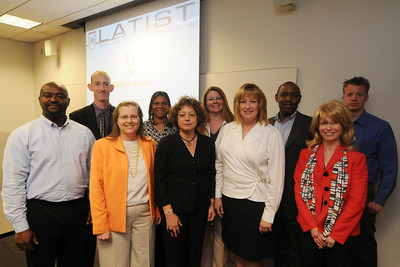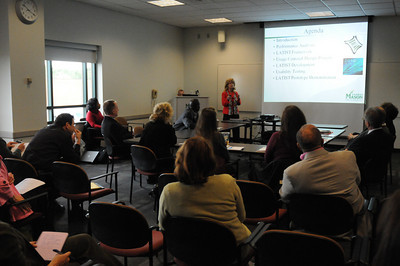College of Education and Human Development
Instructional Technology Students Develop Tools for Industry
July 27, 2010
Today's students have grown up in a world of technology, but many professors struggle to identify how to best incorporate technology — blogs, wikis, computer games — into the classroom.
But now there is a tool that can assist faculty members with evaluating, selecting and integrating technology into their teaching.

The team that worked on the LATIST project,
with professor Nada Dabbagh at center. From left,
George Koduah, James Turner, Sue Dass, Shantell Hampton,
Dabbagh, Sally Byrd, Debra Moore, Professor Kevin Clark,
Susan Conrad and Ryan Curran. Not pictured is Salim Al Waili.
Creative Services photo
Graduate students in Mason's Instructional Technology immersion program have developed that tool: Learning Asset Technology Integration Support Tool (LATIST). A learning asset can be a face-to-face course, online course, hybrid course, podcast or tutorial.
While it may appeal to a larger market, the prototype designed at Mason is intended for use by the Defense Acquisition University (DAU), a corporate university that provides certification training and learning opportunities for the Department of Defense (DoD) workforce.
"Mason's instructional technology program has had a longstanding relationship with DAU, and partnering on the immersion program project seemed like a natural fit," says Nada Dabbagh, associate professor of instructional technology in the College of Education and Human Development.
Mason's Immersion Program teams up eight to 10 full-time students in several project-based experiences that require them to use their instructional design, development and management skills through real-world practice.
"Immersion projects are selected based on their complexity in addressing instructional design and technology principles and processes. We also seek to partner with organizations that are capable of appropriating the funds necessary to complete the project."
Scope of the Task
Since DAU has a geographically dispersed workforce, the nine-person Mason team was tasked with improving the efficiency and effectiveness of the DAU online training programs and consulting capabilities.

Creative Services photo
Specifically, DAU asked the team to provide a framework for incorporating innovative and advanced technology learning designs into DAU's existing training curricula.
"The original project proposal outlined six technology areas for us to research," says James Turner, an active-duty Marine who was a member of the Mason team.
He explains that as team members worked through the instructional design process, which included a detailed performance analysis, they found three categories in particular that would best serve the needs of the client: mobile technology; social media and virtual worlds/games; and simulations.
After selecting the technologies, the team set about designing LATIST. When DAU faculty members go to the LATIST website, they can learn more about the tool through videos, explore what research says about the technologies offered, select the best technology for their course and, finally, learn how to appropriately integrate the technology into a specific class.
Meeting the Client's Needs

The LATIST team presents their prototype to DAU representatives.
Creative Services photo
What makes LATIST a truly innovative tool is that it offers the user two different ways to select the right technology for their needs: a "decision aide" and a "factors grid."
"As we started to conceptualize LATIST as a performance-support tool, we quickly became aware that the particular role a user represents or fulfills at DAU would affect how they choose to use LATIST," says Turner.
"By creating scenarios and using cases of possible interactions with LATIST based on those user roles, we saw the need to have two distinct tools to aid in the decision-making process."
The decision aide allows users to find a technology that aligns with their learning outcomes, while the factors grid allows users to search for a technology that works with their budget, time and technological constraints.
Says Moore, "The factors grid provides a way to verify that a chosen technology is, in fact, the best technology to integrate into the course."
Immersion program students spent two full semesters and about 1,200 hours working on the project, which they presented to DAU representatives in May.
Extremely impressed with the depth of information provided by the tool and excited about the possibilities, DAU officials are now looking for a way to host the system that is compatible with DoD security requirements.
"The immersion student teams always do an outstanding job, especially with regard to the final project deliverable and presentation," says Dabbagh.
"Despite initial feelings of anxiety and confusion, which is expected in a problem-based learning environment, and despite small bumps along the way, we are always impressed with the quality of the students' performance and their ability to link theory to practice."
By Jennifer Edgerly
